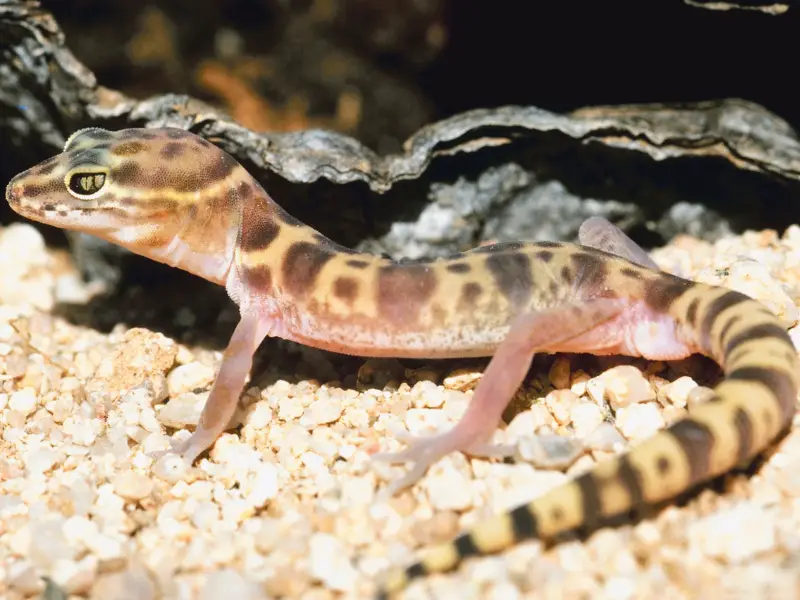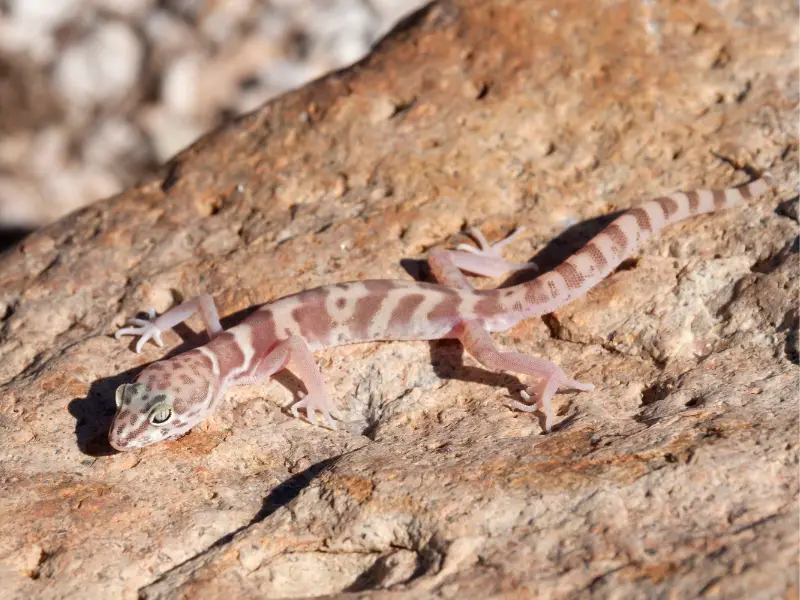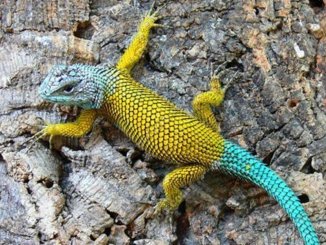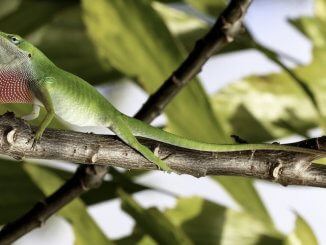The western banded gecko (Coleonyx variegatus) is a reptile of the Eublepharidae family, defined by the C. variegatus’ moveable eyelids and nonadhesive (lacking lamellae) toepads.
The lizards thrive in hot, harsh environments, including dry, barren sand dunes and rocky areas.
They can thrive in captivity if kept in a large terrarium with substrates and temperatures that resemble their natural habitat.
Western Banded Gecko Facts & Overview

| Common name | Western banded gecko |
| Scientific name | Coleonyx variegatus |
| Distribution | Mohave and Sonoran deserts |
| Size | 3–6 inches |
| Life Expectancy | 5–8 years |
| Color | Dark brown crossbars on a pale yellow, pink, tan, or cream background. The eyelids are edged white. The belly is translucent. |
| Diet | Insects |
| Minimum Tank Size | 10 to 20-gallon or 2' x 1' x 1' tank or vivarium |
| Temperature | 80°F (26.7°C) |
| Care Level | Intermediate |
Origin
The western banded gecko originates in the Southwestern US and Northern Mexico, extending from below sea level to 4,986 feet.
Colors, Patterns, and Sizes
Eublepharids are known as “eyelid geckos” for their freely-moveable eyelids and ability to blink and close their eyes. The species are also differentiated from wall climber geckos by their lack of adhesive lamellae on their toes.
The western banded gecko typically measures 3 inches long, excluding the tail, and some grow to 6 inches long.
The body is covered in small, soft, granular scales. The toes are slender and aren’t adhesive like other gecko species. The tail is bulky, slightly constricted at the base, and measures about the length of the gecko’s body.
The head and body are modeled light brown, the tail has indistinct rings, the belly is translucent, and between the legs, it is colored pale yellow, pink, tan, or cream with dark brown crossbars.
Male western banded geckos are defined by spurs, called preanal pores, under the base of the tail.
Typical Behavior
Like other geckos, the western banded gecko is nocturnal. During the day, it hides and hunts under debris and in moist crevices, and in the summer, it can be seen crossing roads.
The western banded gecko uses its tail to escape predators and sustain the gecko in lean times. The tail holds fat, food, and water that sustains it energetically for up to nine months during times of drought like winter dormancy.
When threatened, the gecko stands on its hind legs and raises its tail over its back. The tail has special fracture planes and constricting blood vessels that allow it to break off in order to escape a predator.
Tail regeneration, however rapid, expends the gecko’s energy and can jeopardize the gecko’s survival. The regenerated tail is also shorter, has different scales and color patterns than the original, and lacks fracture planes.
The western banded gecko eats its old skin after shedding it.
Western Banded Gecko Husbandry
The western banded gecko is occasionally available in the pet trade. Though the species is commonly wild-caught and sold cheaply, the geckos are easy to breed in a home tank.
Keep several female geckos together with one male gecko in a large tank or vivarium and maintain the habitat to resemble the species’ natural habitat to help them thrive.
Habitat Requirements

Keep one to six adult geckos in a 10 to 20-gallon or a 2′ x 1′ x 1′ tank or vivarium. Males may be aggressive towards one another, so keep a balance of one male to several females in one tank.
While 10 gallons is recommended by many sources to house five adult geckos of this species, a larger enclosure of around 20 gallons is recommended by some sources for housing three geckos. Larger habitats are the best option to support the well-being of any species.
Eublepharids don’t have the same ability to climb as Gekkonidae. However, the species is still agile and inquisitive and could escape if the habitat isn’t secured.
Replicate the gecko’s natural habitat. Provide a sand substrate (avoid silica sand), supply water in a shallow bowl, and decorate the habitat with various rocks and hollow bark for the lizard to explore, burrow under, and rub on during shedding.
Provide a piece of damp moss and plant the habitat with live, drought-tolerant plants to maintain humidity and aid in shedding. Moss should be dampened about once per week and replaced monthly.
Plants to include in the gecko’s habitat can include:
- Crassula
- Sedum
- Carex grass
- Opuntia cactus
- Aloe vera
- Agave
- Haworthia
Keep debris and burrows lightly misted during the day to provide humid areas for the geckos to hide, and consider covering three sides of the habitat to darken the enclosure and reduce the gecko’s stress.
Maintain the habitat temperature around 85°F during the day and reduce the temperature by 10° at night. Heatpads and/or a red bulb can be used to maintain habitat heat.
Availability in the Pet Trade
Collecting and sealing western banded geckos is typically prohibited where they are found naturally.
However, they are bred legally and available in the pet trade in some areas – check your local state regulations to find out if it’s legal to keep, capture, or sell geckos in your area.
Ensure the breeder or online resource you purchase from is licensed.
Diet
The species hunts during the day. It hunts in rodent burrows for spiders, baby scorpions, insects, and other small arthropods. The gecko stalks its prey and lunges to capture it in its jaws.
In captivity, the geckos should be fed as many as three times per week and supplied as much food as they can eat in about 5 minutes. They them with live insects and give the geckos a calcium supplement dusted on the prey every other feeding.
Feed western banded geckos a varied diet in captivity, including:
- Black soldier fly larvae
- Crickets
- Discoid roaches
- Dubia roaches
- Mealworms
- Mealworm beetles
- Red runner roaches
- Silkworms
- Small hornworms
Prey should measure no larger than the gecko’s head.
Conservation
Western banded geckos are currently classified as a species of least concern by the IUCN and aren’t classified as an at-risk species.
Life Cycle
The geckos are sexually mature when they measure 2 inches in length (not counting the tail). They breed during April and May. Eggs are laid in one to three clutches of two eggs each in May through September, and the eggs hatch in about 45 days.
Breeding

The western banded gecko is easy to breed in captivity. Partner one male with up to five female geckos and put damp moss and hides in the habitat for the geckos to lay their eggs.
To breed the geckos, start in November by reducing the habitat’s temperature to around 65°F and reducing daytime light to eight hours.
Maintain cool temperatures for two months to support the enlargement of the male’s testes and the strengthening of the sperm. During this time, the geckos should maintain hydration by drinking fresh water daily. Feeding may continue, though the geckos may eat less than usual or may sustain themselves only by the fat stored in their tails.
In mid-February or early March, increase the habitat temperature and length of daylight to support increased feeding and breeding.
The male breeds with the female at night.
The gravid female develops two eggs that can be seen through her translucent belly.
When the eggs are detected, a nesting box should be prepared in the habitat by using a small plastic box filled with lightly moist moss or vermiculite.
Check daily for eggs in the box, and once laid, increase the temperature in the box to 80 to 85°F with 80% humidity by moistening the substrate in the box and placing the box under an incubation light. Keep the eggs buried halfway in the box substrate, and don’t wet the eggs directly.
The eggs should be incubated at warm temperatures for six weeks. The eggs will then hatch 1-inch-long hatchlings. Feed the juveniles every day until they are sexually mature, at which time they can eat every other day.
Handling
Banded geckos are small and skittish and shouldn’t be handled regularly. Though individual animals within species are different, most geckos aren’t tolerant of humans.
Interact closely with your gecko by feeding it with tongs.
Should You Get a Western Banded Gecko?
Western banded geckos are not common in the pet trade, though they can be found sold by official breeders. The species is easy to breed and care for in a home habitat.
A western banded gecko may be a great addition to your home habitat if you have space for a 10-gallon tank or terrarium in your home, keep temperatures around 80°F, feed them small insects, supply fresh water, and provide a fine substrate with moist places to hide.



